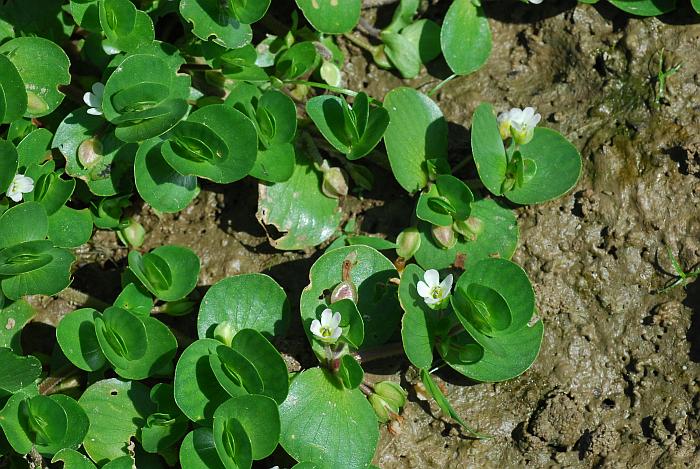Bacopa rotundifolia (Michx.) Wettst.
Water Hyssop

Native
CC = 6
CW = -5
MOC = 39
© SRTurner
Bacopa rotundifolia (Michx.) Wettst.Water Hyssop | |
 |
Native CC = 6 CW = -5 MOC = 39 |
© SRTurner |
|
Family - Plantaginaceae Habit - Annual or perennial forb, with fibrous roots, aquatic or sometimes terrestrial when stranded on mud. Stem - Floating, usually with lower portion submerged, or prostrate on mud with ascending tips, rooting at the lower nodes, not angled, moderately to densely and finely short-hairy, at least on newer growth.
Leaves - Opposite, sessile, 1.0-3.5 cm long, 1.0-2.8 cm wide, relatively thick (but drying very thin and fragile), broadly spatulate to orbicular, simple, entire, unlobed, rounded at the tip, shallowly cordate to rounded or broadly angled at the base, usually slightly clasping the stem, the margins sometimes finely short-hairy, the venation palmate with 5-9 main veins, the surfaces glabrous at maturity, the upper surface somewhat shiny.
Inflorescence - Axillary, the flowers usually 1 or 2 per leaf axil, the flower stalks 6-23 mm long; bractlets absent.
Calyx - Calyces 3.0-4.5 mm long at flowering, becoming enlarged to 4-6 mm at fruiting, deeply 5-lobed nearly to the base, glabrous, the outer 3 lobes leaflike, ovate to broadly ovate, the inner 2 inconspicuous, lanceolate.
Flowers - Perfect. Corollas 4.5-9.0 mm long, weakly zygomorphic, 5-lobed, glabrous, the tube slightly shorter than to about as long as the lobes, usually white with a yellow throat, the throat open, the lobes collectively bell-shaped above the slender tube, oblong-obovate with more or less truncate but shallowly notched tips. Fertile stamens 4, the filaments of 2 lengths, not exserted, the anthers attached near their midpoints, the anther sacs parallel; staminodes absent. Style 1, not exserted, forked near the tip, each branch with an expanded, irregularly oval, cushionlike stigma at the tip.
Fruits - Capsules, 3.5-5.5 mm long, globose to broadly ellipsoid, glabrous, usually enclosed within persistent calyx, the 2 locules equal in size, dehiscent longitudinally by 4 valves. Seeds numerous, 0.4-0.6 mm long, ellipsoid to cylindric with a minute tail-like appendage at each end, the surface yellowish brown, with a network of fine ridges.
Flowering - May - September. Habitat - Ponds, sloughs, swamps, ditches, rice fields. Aquatic or stranded on mud. Origin - Native to the U.S. Lookalikes - None. Ludwigia peploides occupies a similar habitat and may appear similar at a distance, but the leaves are much different and the flowers yellow instead of white. Other info. - This species is found in scattered locations throughout Missouri. Its broader range is mainly in the U.S. Midwest and Plains states, and Canada. It is easy to identify by its habitat, its round, succulent-looking leaves, and small white flowers. Look for it in marginal areas of sloughs and ponds, where the shoreline has slowly receded over the growing season. The tender stems and leaves of this species are eaten by wildlife. Photographs taken at Catawissa Conservation Area, Franklin County, MO, 9-10-2017 and 9-14-2017 (SRTurner). |